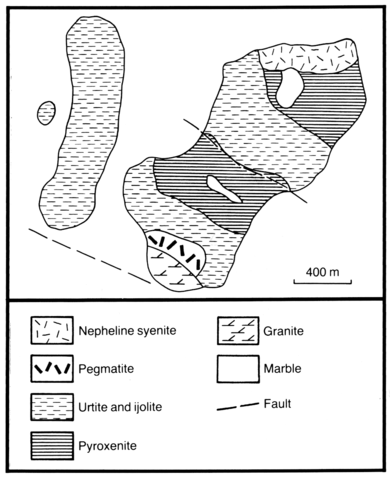stripes
Ijolite and urtite form two bodies separated by Upper Proterozoic marbles. The western body of 1.5x0.35 km mainly comprises ijolites, which in the western and southern parts are enriched in calcite, with numerous very coarse-grained calcite veins. The calcite-bearing ijolites are cut by nepheline syenite veins. Calcite from calcite-silicate rocks and calcite veins has Ù13Co/oo from +1.6 to -6.1. The eastern part of the complex is extremely variable in composition. There are extensive areas of pyroxenite among ijolite-urtites. In the southern part nepheline-zeolite pegmatites outcrop. The rocks of the ijolite-urtite series are composed of nepheline, withup to 85% in the urtites, and clinopyroxene, which is fassaitic in composition. Postmagmatic alteration of the urtite-ijolites resulted in the development of plagioclase, grossular and calcite. The most typical accessory minerals are apatite and titanite.
KONONOVA, V.A. 1961. Urtite-ijolite intrusions from south-east Tuva and some problems of their genesis. USSR Academy of Sciences, Moscow. 120 pp.
KONONOVA, V.A. 1962. The primary layered Ba'ankol intrusion of hedenbergite nepheline syenite. In O.A. Vorob'eva (ed) Alkaline rocks of Siberia. 39-70. USSR Academy of Sciences, Moscow.
KONONOVA, V.A. 1976. The Jacupirangite-urtite series of alkaline rocks. Nauka, Moscow. 214pp.
KONONOVA, V.A. and SHANIN, L.L. 1973. On the radiogenic argon in nepheline in connection with the question of how good it is for the dating of alkaline complexes. In G.D. Afanas'ev (ed), Geological-radiogenic interpretation of the divergence of age figures. 40-52. Nauka, Moscow.

